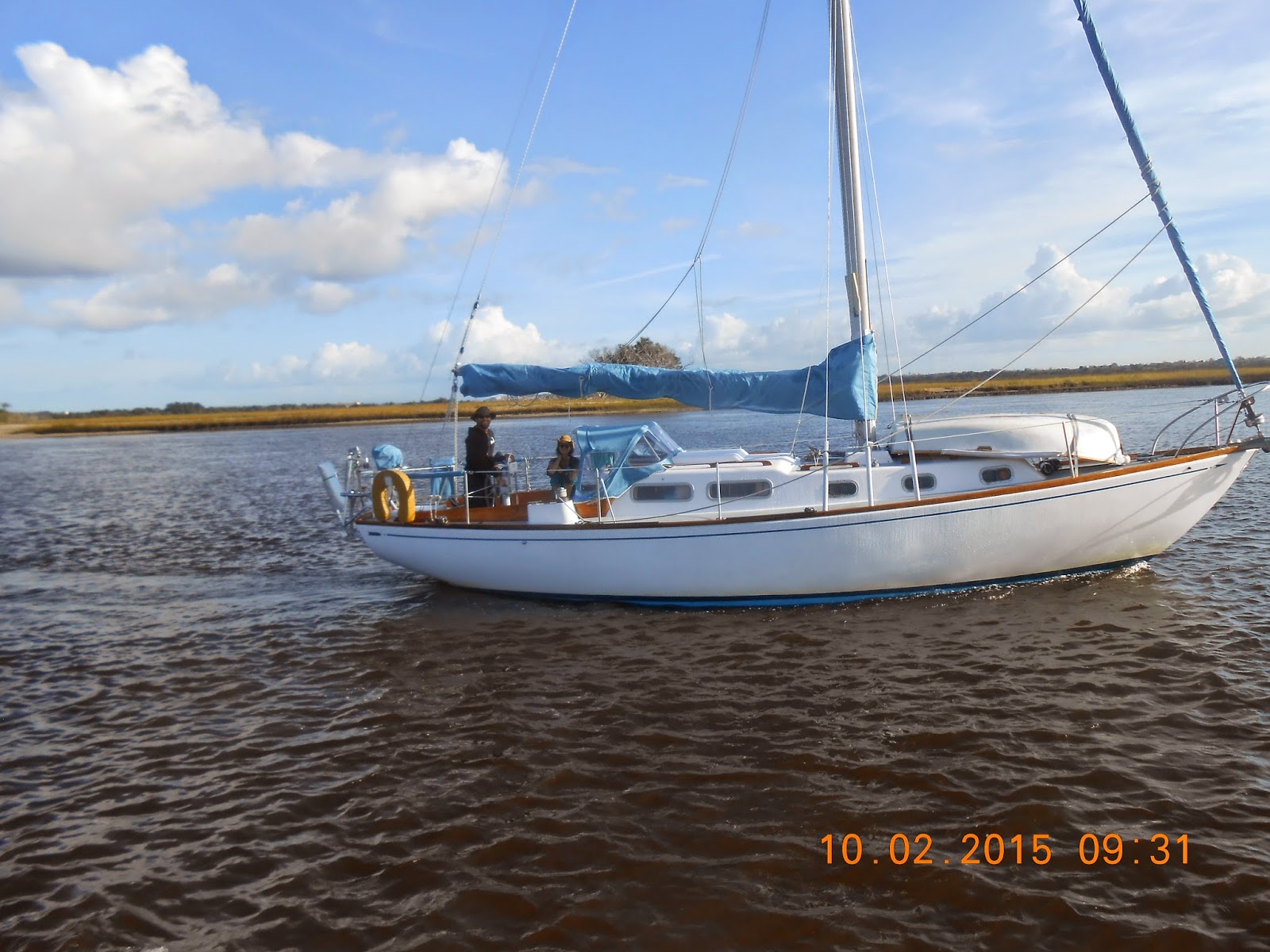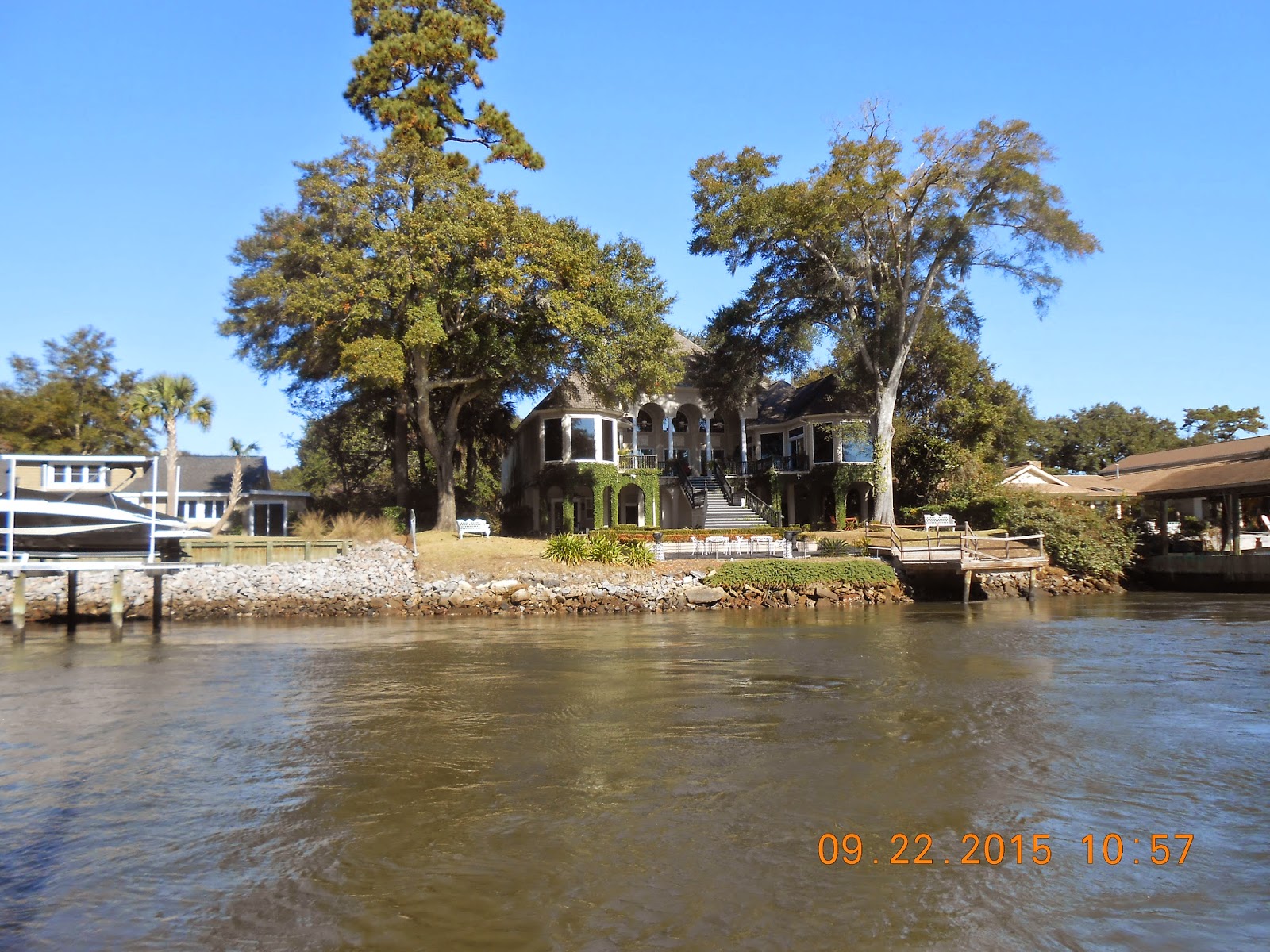Today Emily and I were hypnotized, mesmerized and
bewitched by manatees at Blue Springs State Park about an hour northwest
of Titusville, where FLICKA is tied up at the Westland Marina awaiting haul out.
Titusville is near Cape Canaveral and the Kennedy Space Center. They love their
astronauts down here. Titusville is home to the Astronaut Hall of Fame and NASA
attractions (National Aeronautics and Space Administration).
Florida has many unique natural features, including a
number of fresh water springs that issue forth crystal clear water at a
constant year round temperature of 71 to 75 degrees F. These springs are a hit
with scuba divers and swimmers and manatees – which were here
first.
Blue Springs, an hour northwest of Titusville, is one
of these. This spring has, as its source, a nearly circular pool about 100 feet
in diameter and 30 feet deep. One hundred million gallons of blue-green tinted
water flows daily from it into the St. Johns River. The spring run to the St.
Johns River is about a mile long, maybe a quarter mile wide and very deep in
places.
Blue Springs is one of their winter havens. I bet they
have been coming here for tens if not hundreds of thousands of years. Think about
that for a moment.
In addition to Florida’s springs, these days they also
seek out areas around power plants, which discharge heated water as part of
their normal operations. During the winter they bask in these warm waters, lazily
cuddling up to one another and feeding on local aquatic vegetation, doing what
manatees do – which seems to be a whole lot of nothing most of the time.
The latest count at Blue Spring is somewhere around
140 individuals. Of course now a days the manatees share these springs with human
beings, Blue Springs having become a swimming mecca to thousands annually.
Fortunately swimming is not allowed during the specific time when the manatees
are present in the winter months. (Thank God for those onerous, freedom robbing
guvmit regulators.)
These animals are big. They are referred to, unattractively
I think, as sea cows. A large adult might go ten - twelve feet and weigh 1,200
– 1,500 lbs. Calves are 70 lbs. or so and maybe 4 feet long. They are surprisingly
agile and, anthropomorphically speaking, act rather playfully. We watched them
swim slowly and gracefully in loose formations of two to five animals.
Sometimes a pair seemed to be cuddling and one of the pair would place its flipper
on the other and sort of hitch a ride. Occasionally they would surface to
breathe (being mammals and all) and sometimes roll over onto their backs, behavior
reminiscent of sea otters I have seen in other parts of the world. All in all a
docile critter, with a gentle nature and manner. Their face is something only a
mother could love.
Manatees are endangered. Sadly, most of the remaining
individuals have body scars from boat propellers – primarily power boats but I
suspect a few sail boats are probably also culprits.
Scaring is used by state and federal biologists to
identify individual manatees. Let me repeat that for effect– most of the
remaining individuals of this species on this planet have been scared by boat
propellers and that is how we identify each individual – by its own unique scar
signature.
All along the intra-coastal water way in this neck of
the woods – there are prominent signs announcing that these are manatee waters.
The signs caution boaters to be careful and not exceed 25 mph. Twenty-five MPH
is fast on the water. A boat doing 25 mph hardly has time to miss these
ponderous animals who swim slowly along just below the water’s surface. I’m not
sure what the rationale is for that speed limit.
The good news is that dedicated natural resource managers
in these parts are working on manatee conservation and lots of citizen volunteers’
help implement manatee education programs for the public. At Blue Springs Park at the end of the
“manatee walk’ was a display table manned by a group of volunteers who inform
people about manatee status and encourage folks to get involved with the conservation
effort. They are amazing people – very dedicated to their cause.
So anyway – that’s my manatee story and I’m sticking
to it.
God bless these people.
Lately I have been thinking and reading about Earth’s
threatened and endangered plants and animals. Most of us have general knowledge
about that subject, but when you start to dig a little and become a little
better educated about basic ecological principles, the impact of human
activities on plant and animal populations becomes suddenly a much larger, compelling
and important subject I think. By many accounts I have studied, many animal and
plant species are on the brink of extinction. Looking down the road, and if
some predictions are correct, I can’t help to wonder what the world will be like
without them. Maybe it doesn’t matter. I have never seem a white rhinoceros or
lion or springbok or, for that matter, most of the animals biologists tell us
are endangered or threatened, but the sadness I felt when I recently learned
that there are only 5 white rhinos left on earth was real enough.
Can we somehow live on this planet with other species
besides those we have domesticated? So far evidence suggests that we are not
able to do that. Many of the world’s species have become extinct on our watch
and numbers of many other species are fast dwindling. Much of the overall story
and current picture is disheartening.
However, there is a cadre of remarkable scientists,
natural resource managers and citizen activists working world wide to improve
this dismal picture and in some cases, there are teams of people protecting the
last few remaining members of some species – like New Zealand’s kakapo (I know,
go ahead and laugh.). The kakapo, a large, flightless, nocturnal New Zealand
parrot, was once was a common bird on New Zealand’s islands, but today there
are one hundred and twenty-six individuals left, those individuals having been
captured and ‘translocated’ to three small, remote predator-free islands. The
kakapo population has been ravaged by introduced cats, opossums, rats and
stoats (a kind of weasel).
By the way – here is an interesting pearl – New
Zealand never had a native population of mammals of any kind (except for a few
bats). Any mammal on New Zealand’s islands is an exotic (except for those damn
bats) and they have played hell on the native plants and animals. Because of
the lack of mammalian species in New Zealand prior to human habitation, bird
species flourished there. Of course that is no longer true because once
predacious mammals were introduced the birds began dropping – well - like
flies. A number of moa species (large flightless birds) are gone and the kiwi
(another flightless bird) is threatened. New Zealand had a thing for evolving flightlessness
in birds, after all if there aren’t any predators why expend all that energy
flying around. [Information about New Zealand extracted from a recent article
in the New Yorker, December 22, 29, 2014. The
Big Kill, New Zealand’s invasive mammal species, by Elizabeth Kolbert.
I recommend two very well researched and written books
on the broad subject of animal extinction.
The first is No Way Home: the Decline of the
World’s Great Animal Migrations by Princeton Professor of Public Affairs,
Ecology and Evolutionary Biology, David S. Wilcove. Dr. Wilcove chronicles
stories of the demise of large land and marine mammals, insects, amphibians and
other animals and addresses reasons for those declines.
The second – The Sixth Extinction – an Unnatural
History by Elizabeth Kolbert, New York staff writer for the New Yorker
magazine. Ms. Kolbert talks about the world’s known periods of animal and plant
extinctions, the first five being caused by ‘natural’ events and the sixth
which we are living through the latest and largest in scope and depth, largely
caused by human activities. She writes with equal passion about the people
trying to save engendered species and the species themselves.
So Emily and I ended up our day by driving back down
to Titusville, and visiting, for a second time, the 140,000 acre Merritt Island
National Wildlife Refuge, an area of coastal dunes, saltwater estuaries and
marshes, freshwater impoundments, scrub, pine flatwoods, and hardwood hammocks that
provide habitat for more than 1,500 species of plants and animals.
We drove the 12 mile Black Point Wildlife Trail and
noted the following bird species: American Widgeon, Northern Shoveler, Hooded
Merganger, Wood stork, Double Crested Cormorant, White Pelican, Brown Pelican,
Pied-billed Grebe, Great Blue Heron, Great Egret, Tricolored Heron, Reddish
Egret, Cattle Egret, Royal Tern, White and Glossy Ibis, Roseate Spoonbill,
Black Vulture, Turkey Vulture, Common Gallinule, Ring billed and Laughing Gulls,
Fish Crow, Common and Boat-tailed Grackles and American Coot and many old coots
doing what we were doing – just hanging around.
Namaste’














































